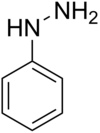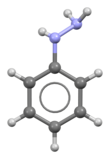
Back فنیلهیدرازین AZB Fenylhydrazin Czech Phenylhydrazin Danish Phenylhydrazin German Fenil-hidrazino Esperanto Fenilhidrazina Spanish فنیلهیدرازین Persian Fenyylihydratsiini Finnish Phénylhydrazine French Fenilidrazina Italian

| |||
| |||
| Names | |||
|---|---|---|---|
| Preferred IUPAC name
Phenylhydrazine | |||
| Other names
Hydrazinobenzene
| |||
| Identifiers | |||
3D model (JSmol)
|
|||
| ChEBI | |||
| ChEMBL | |||
| ChemSpider | |||
| ECHA InfoCard | 100.002.612 | ||
| KEGG | |||
PubChem CID
|
|||
| UNII | |||
CompTox Dashboard (EPA)
|
|||
| |||
| |||
| Properties | |||
| C6H5NHNH2 | |||
| Molar mass | 108.144 g·mol−1 | ||
| Appearance | Colorless to pale-yellow liquid or solid[3] | ||
| Odor | faint, aromatic[3] | ||
| Density | 1.0978 g/cm3 | ||
| Melting point | 19.5 °C (67.1 °F; 292.6 K) (24 °C for hemihydrate) | ||
| Boiling point | 243.5 °C (470.3 °F; 516.6 K) (decomposition) | ||
| Vapor pressure | 0.04 mmHg (25°C)[3] | ||
| -67.82·10−6 cm3/mol | |||
| Hazards | |||
| NFPA 704 (fire diamond) | |||
| Flash point | 88 °C; 190 °F; 361 K[3] | ||
| Lethal dose or concentration (LD, LC): | |||
LD50 (median dose)
|
| ||
| NIOSH (US health exposure limits): | |||
PEL (Permissible)
|
TWA 5 ppm (22 mg/m3) [skin][3] | ||
REL (Recommended)
|
Ca C 0.14 ppm (0.6 mg/m3) [2-hr] [skin][3] | ||
IDLH (Immediate danger)
|
Ca [15 ppm][3] | ||
Except where otherwise noted, data are given for materials in their standard state (at 25 °C [77 °F], 100 kPa).
| |||
Phenylhydrazine is the chemical compound with the formula C6H5NHNH2. It is often abbreviated as PhNHNH2. It is also found in edible mushrooms.[5]
- ^ Merck Index, 11th Edition, 7264.
- ^ Pure component properties
- ^ a b c d e f g NIOSH Pocket Guide to Chemical Hazards. "#0499". National Institute for Occupational Safety and Health (NIOSH).
- ^ "Phenylhydrazine". Immediately Dangerous to Life or Health Concentrations (IDLH). National Institute for Occupational Safety and Health (NIOSH).
- ^ Andersson, H. C.; Gry, Jørn (2004). Phenylhydrazines in the cultivated mushroom (Agaricus bisporus). Nordic Council of Ministers. ISBN 9789289301978.
© MMXXIII Rich X Search. We shall prevail. All rights reserved. Rich X Search


